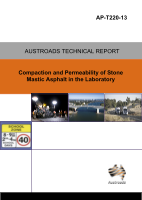Pavement

- Publication no: AP-T220-13
- ISBN: 978-1-921991-68-4
- Published: 16 January 2013
- PDF (free) Download
Stone Mastic Asphalt is coarser in gradation than dense graded asphalt and in emphasising the coarseness of the mix it tends to become difficult to compact in the laboratory. Five compaction methods were investigated to determine how these affected the volumetric and some physical properties.
Volumetric properties are the key component in asphalt mix design and the method of determining the most basic parameter, the bulk density, was investigated. Four methods of determining bulk density were investigated and it was found that each method yields different results.
The amount of aggregate breakdown during compaction was measured; it was found that impact hammer compaction methods resulted in a greater change in the gradation than gyratory compaction or segmental wheel compaction.
Analysis of the compaction data to determine if lock-up was evident found that the excessive amount of variation between compaction of samples meant that no meaningful conclusions could be drawn.
Resilient modulus was measured on the samples where it was found that the compaction method had a significant effect on this property. However, the compaction method was not found to affect the permeability.
- 1. INTRODUCTION
- 2. Objective
- 3. Measurement of Bulk Density
- 3.1. Stage 1: Water Saturation and Mensuration Methods
- 3.2. Stage 2: Method
- 3.3. Results
- 3.3.1. Plastic Samples
- 3.3.2. Asphalt Samples
- 3.4. Conclusions
- 4. SAMPLE COMPACTION REVIEW
- 4.1. Method
- 4.2. Lock-up Results
- 4.3. Estimation of Compactive Effort
- 4.4. Conclusions
- 5. Review of Gradation
- 5.1. Method
- 5.2. Results
- 5.3. Conclusions
- 6. Resilient modulus
- 6.1. Method
- 6.2. Results
- 6.3. Conclusions
- 7. Permeability
- 7.1. Method
- 7.2. Results
- 7.3. Conclusions
- 8. OVERVIEW
- References
